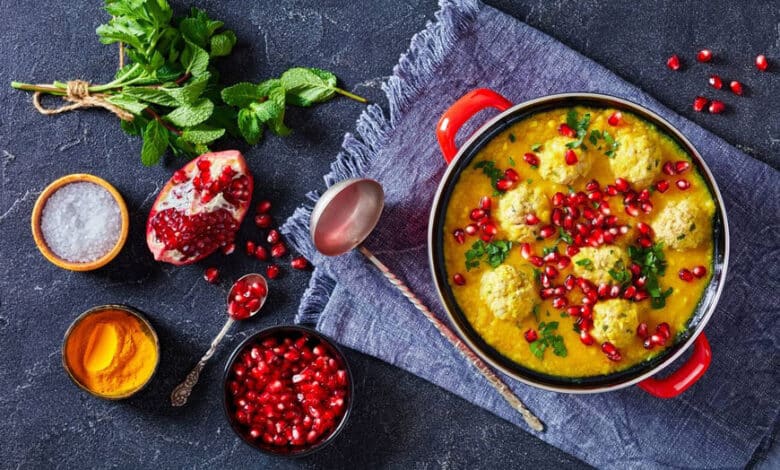
Yalda night, a beautiful ancient tradition in Iran, is celebrated with a variety of foods across different cities. Each city, honoring its own customs, prepares diverse and colorful Persian dishes.
Yalda Night 2025
Sunday, December 21, 2025
یکشنبه، ۳۰ آذر ۱۴۰۴
In this article from SURFIRAN Magazine, we introduce special Yalda night dishes from various cities and explore the philosophies behind these foods. Join us on this delicious adventure.
Contents
1. Morgh Nardooni (Pomegranate Chicken Stew)
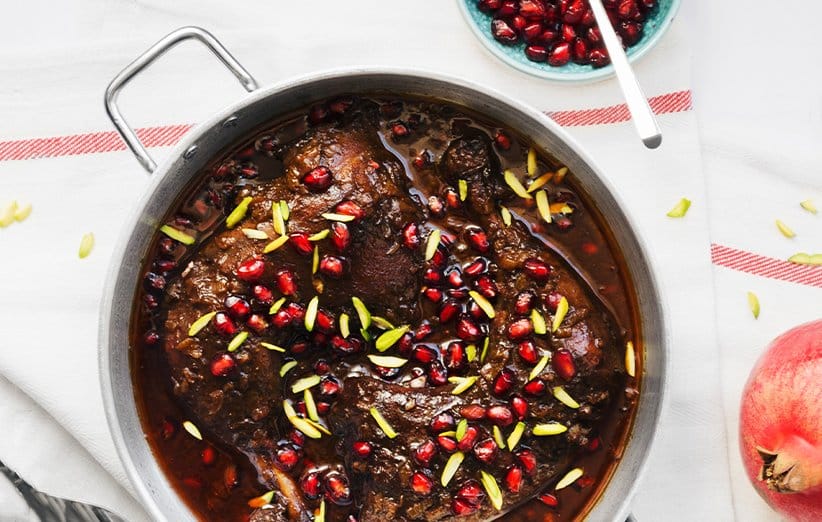
Morgh-e Nardooni, a type of stew from the northern provinces of Gilan and Mazandaran, is cooked differently in each region. It’s a mix of chicken and pomegranate seeds, often blended with other ingredients to taste and typically served with rice.
To prepare this traditional stew, chicken pieces are sautéed with onions and desired spices. After adding pomegranate and tomato paste, the mixture is allowed to cook thoroughly.
Pomegranate seeds and fried onions are heated separately and added to the chicken towards the end of cooking.
2. Khoresht Fesenjan (Persian Pomegranate and Walnut Stew)
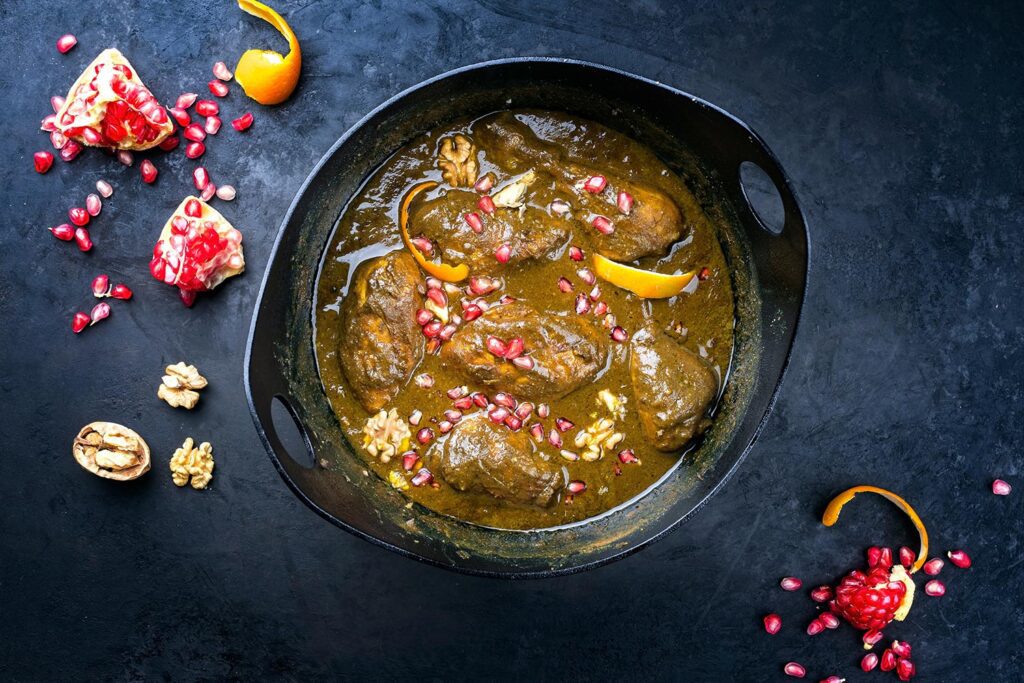
Khoresht Fesenjan, a prestigious Iranian dish, is especially popular in cold seasons. Originating from Gilan Province, it is cooked in various ways across Iran. The taste can range from sour to sweet or semi-sweet, and its color varies based on individual preference.
Northern Fesenjan is typically sour and made with duck or goose meat. In contrast, Azerbaijani versions favor a semi-sweet taste, often adding dried apricots or dates. Central Iranian Fesenjan is usually sweet and prepared with chicken or turkey.
3. Kufteh-e Anar va Gerdu (Pomegranate Walnut and Meatball Stew)
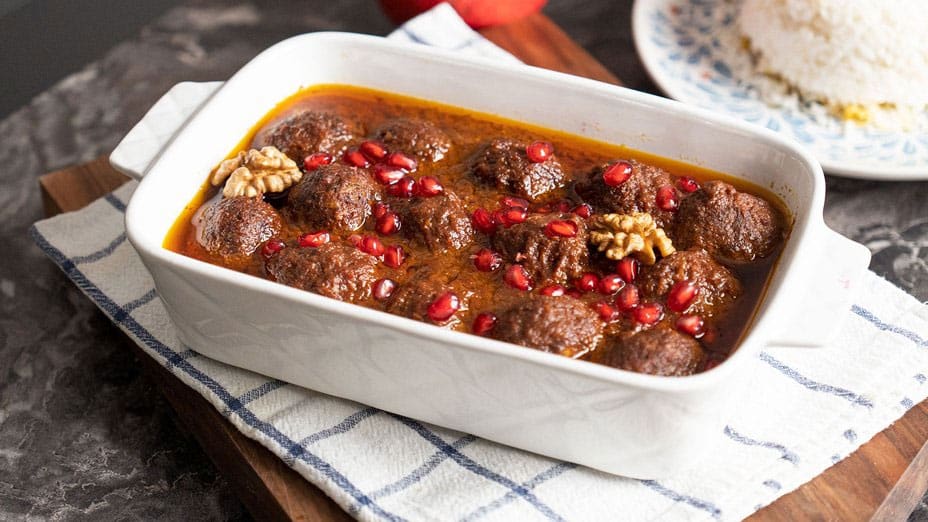
For those who enjoy sour or semi-sweet dishes, Kufteh-e Anar (pomegranate meatballs) is a delightful choice. It’s made by mixing ground meat, crushed walnuts, onions, pomegranate paste, fresh or dried herbs, and spices.
The sauce for these meatballs includes fried onions, ground walnuts, pomegranate paste, tomato paste, pomegranate juice, and various spices. Pomegranate seeds are added to the simmering meatballs in the final 15 minutes, thickening the sauce.
4. Khoresht Beh Aloo (Persian Quince & Plum Stew)
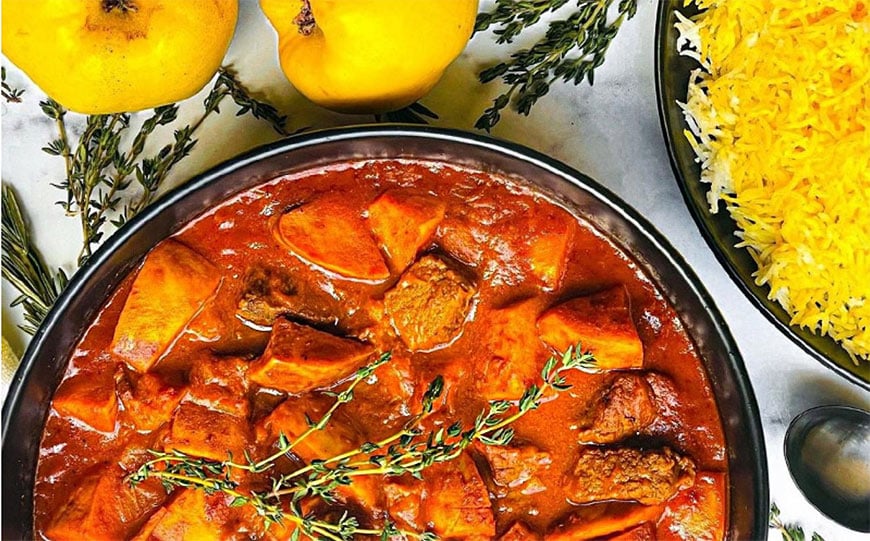
Beh Aloo, a traditional Iranian stew, is commonly cooked in autumn when quinces are plentiful. While it can also be made with frozen quince, the fresh fruit enhances the stew’s aroma and taste.
Typically prepared with lamb or beef, Beh Aloo can also be made with chicken, turkey, or even as a vegetarian dish. Like most Iranian stews, meat is sautéed with onions and spices, then simmered with a bit of tomato paste and water on low heat.
5. Ash-e Anar (Pomegranate Soup)
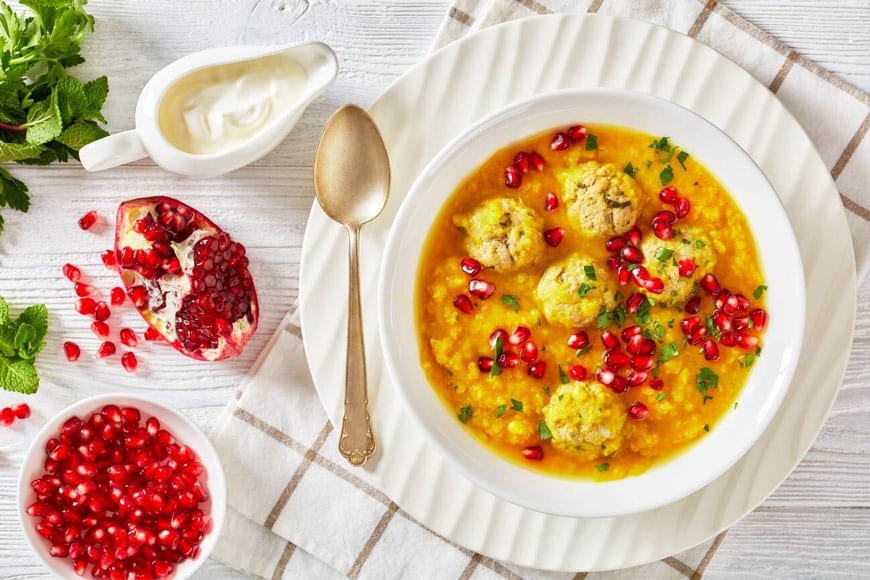
Ash-e Anar, a traditional Iranian soup, holds a special place during Yalda night. This tasty soup usually consists of rice or bulgur, legumes, soup greens, pomegranate juice, pomegranate seeds, and pomegranate paste.
The method of cooking Ash-e Anar varies in different cities, but the final product is quite similar. While some people use split peas and half-milled rice, others prefer bulgur and various legumes.
In Gilan, Ash-e Anar is cooked entirely meat-free. In contrast, people in Azerbaijan mix broth or ground meat with other soup ingredients. In Shiraz, the meat is added as tiny meatballs.
6. Anarbij Stew from Gilan (Gilani Pomegranate Stew)
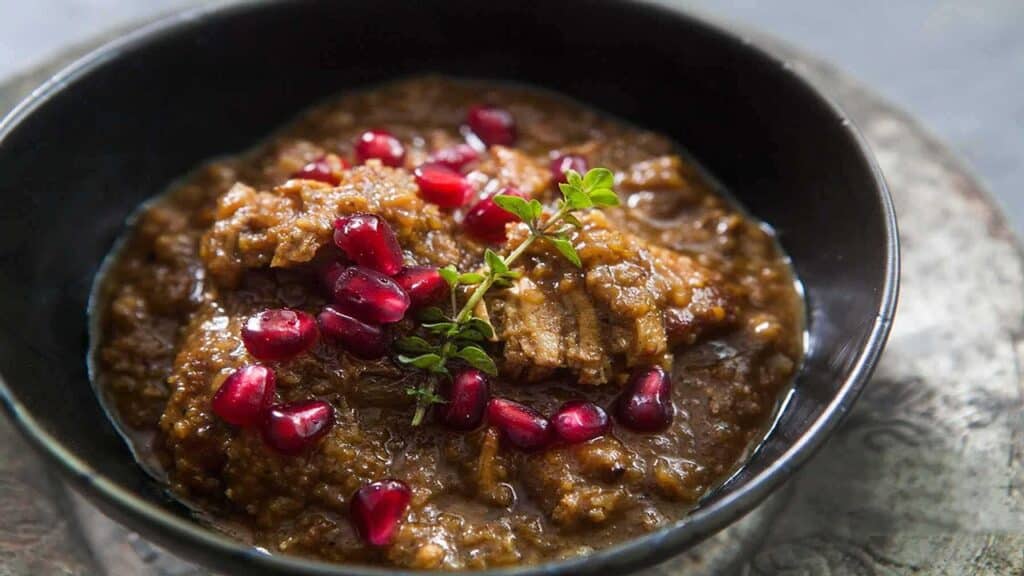
Anarbij, a beloved stew from Gilan province, closely resembles Fesenjan. It’s prepared with a mixture of fragrant herbs including Khakshir, Chochagh, Parsley, Coriander, and Mint. Fried onions, ground walnuts, pomegranate paste, and spices are cooked separately until the oil surfaces. Then, the fried herbs are added to this mixture, allowing the stew to fully cook.
Finally, fried meatballs or, in some cases, chicken pieces are added to the Anarbij stew. After the stew settles, it is served with steamed rice. In some variations, sour pomegranate juice or verjuice is added for a better taste.
7. Anar Polo (Pomegranate Rice)
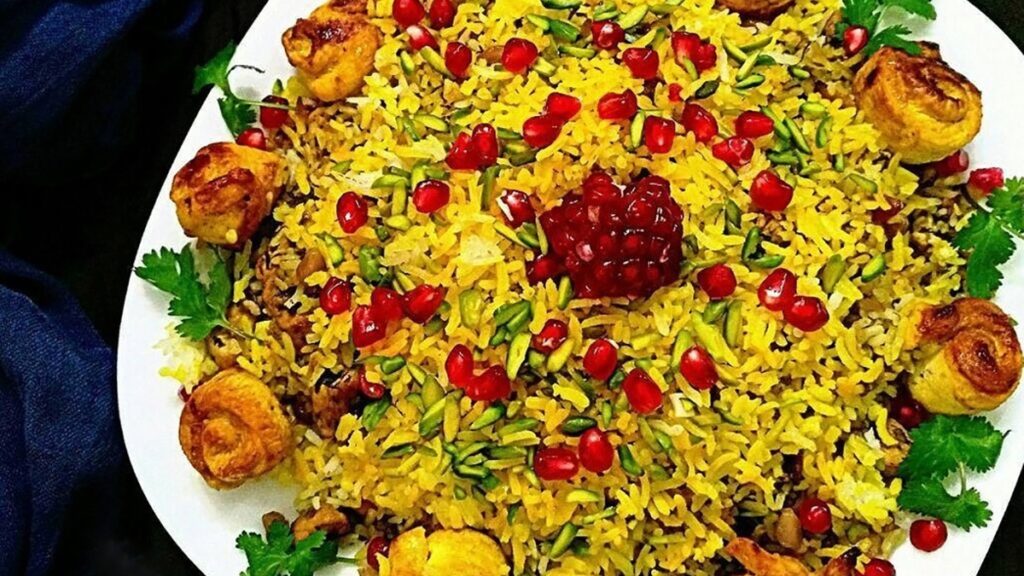
Recognized as a symbol of Yalda, pomegranate finds a prominent place in the Yalda dinner, particularly in cities like Shiraz and Qazvin. Anar Polo is a festive rice dish, often enjoyed in Afghanistan too.
For Anar Polo, rice is cooked separately and mixed with shredded cooked chicken, pomegranate seeds, fried onions, pomegranate paste, slivered pistachios, almonds, and saffron. In Qazvin, chicken strips are fried with onions and spices, then combined with pomegranate seeds, chopped coriander, and slivered pistachios. The mixture is layered with parboiled rice in a pot and left to steam. Carrots and raisins are sometimes added to enhance the flavor and appearance.
8. Morgh-e Shekam Por (Stuffed Chicken)
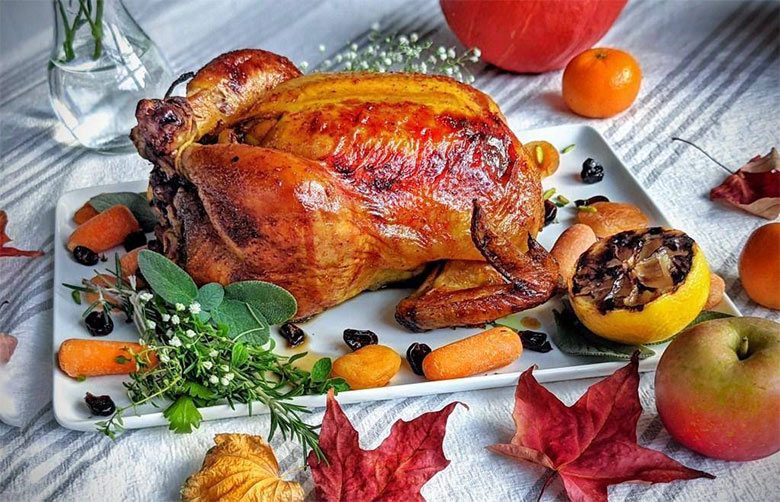
Like many Iranian dishes, Morgh-e Shekam Por has numerous recipes. In northern Iran, it’s typically prepared with aromatic herbs, wild sour plums, and sour pomegranate paste, while other regions might use dried apricots, raisins, and barberries.
Generally, the chicken is seasoned with salt, pepper, spices, and lime juice, then stuffed with a mixture of fried onions, plums, dried apricots, aromatic herbs, raisins, barberries, walnut cores, tomato paste, pomegranate paste, garlic, and more. Some northern regions add sour pomegranate seeds and wild sour plums for an extra tangy flavor.
The chicken is sewn up and cooked with vegetables like carrots, potatoes, and celery, either on the stove or in the oven until golden brown. Some prefer to fully fry the chicken before cooking it with a small amount of water, resulting in a beautifully glazed roast chicken.
9. Khoresht Anar Mosama (Pomegranate and Eggplant Stew)
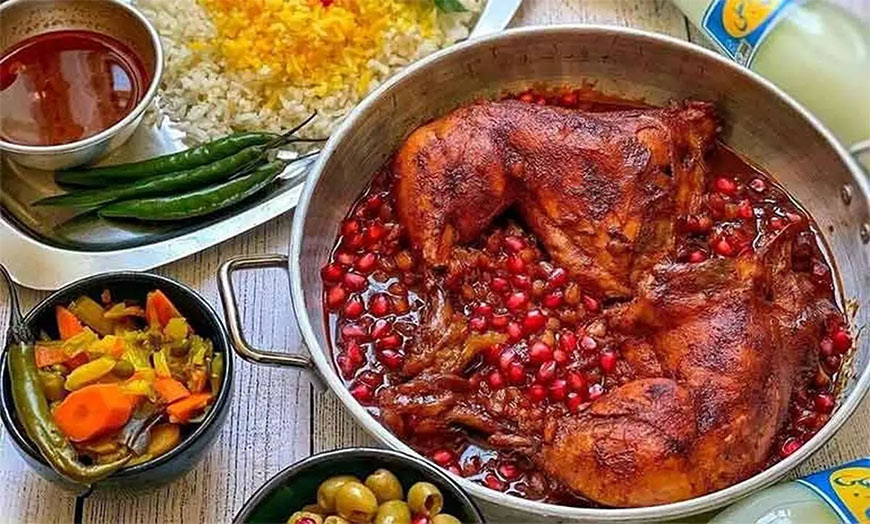
Khoresht Anar Mosama, also known as Pomegranate and Eggplant Stew, can be considered another variant of northern Nardoon, often called “Morgh-e Anari” as well. In its traditional recipe, fried chicken is mixed with sautéed onions, sour pomegranate seeds, a bit of tomato paste, and pomegranate paste, then simmered on medium heat.
10. Ajil Polo (Nuts and Dried Fruits Rice)
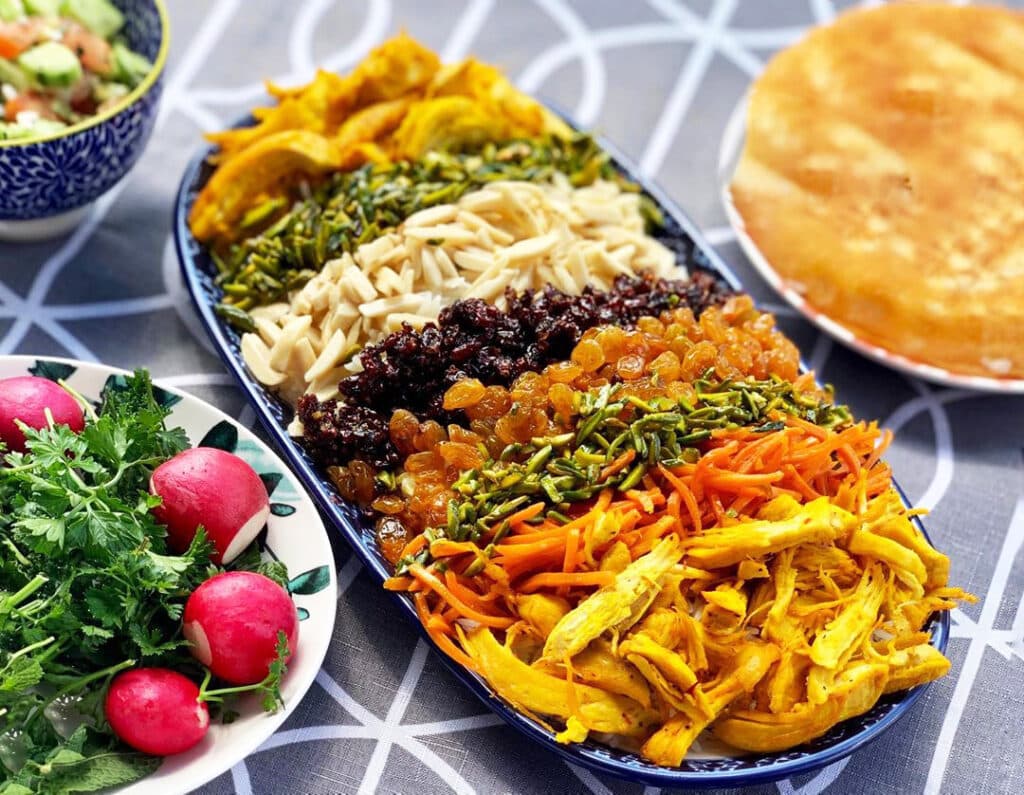
Ajil has always been an integral part of the Yalda spread. Ajil Polo, known in some cities as Jeweled Rice, Maras Polow, or Jeweled Polo, is a luxurious dish often served at important events like wedding dinners, especially among Azerbaijanis.
Typically served with chicken fillet or shredded chicken, it can also include lamb meat or tiny meatballs. The rice is cooked separately, and ingredients like raisins, barberries, slivered pistachios, slivered almonds, candied orange peel, slivered carrots, walnuts, and cashews are sautéed individually.
Sometimes, dried apricots and peaches are added.
After layering the rice, it’s decorated with these ingredients and a bit of fried onion and saffron rice. Some people prefer to steam these ingredients with the rice for a richer flavor and aroma.
The type and amount of nuts used depend on personal preference, and soaking the nuts in rose water before sautéing is recommended for an enhanced aroma.
11. Kadoo Halvai Stew (Butternut Squash Stew)
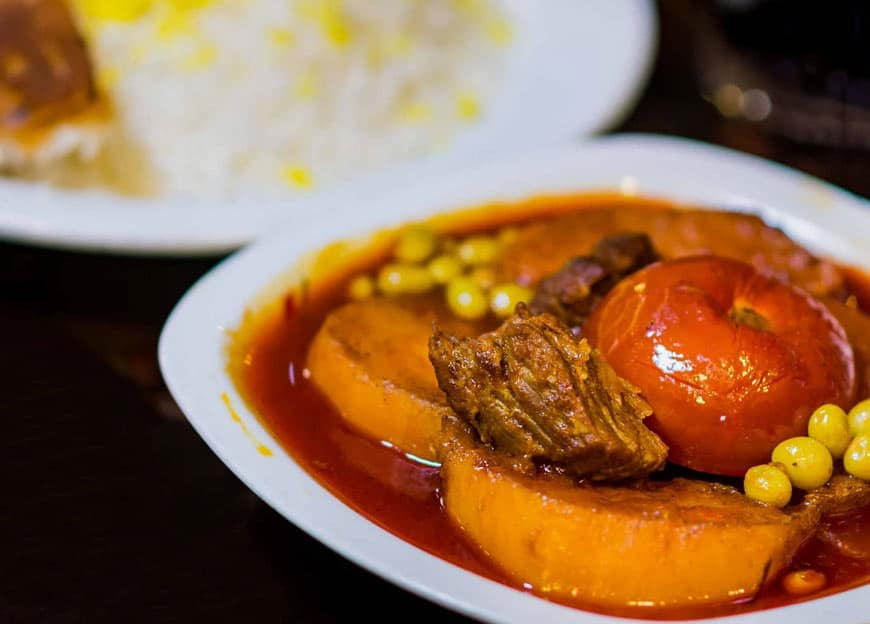
Kadoo Halvayee Stew is a fall specialty, perfect for Yalda night dinners. Its aroma and flavor are enriched with butternut squash and spices like cinnamon and cardamom, leaving a memorable taste. Some cut the squash into cubes and sauté it for the stew, while others prefer to boil and puree it. Both methods yield a visually different but similarly flavored stew, typically balanced with a slightly sweet taste. To adjust the final taste and reduce the sweetness of the squash, you can add lemon juice, sour orange juice, or verjuice towards the end, or use sour orange or verjuice paste. Some also add a bit of sour plum to enhance the stew’s autumnal flavor.
12. Northern Sour Chicken Stew
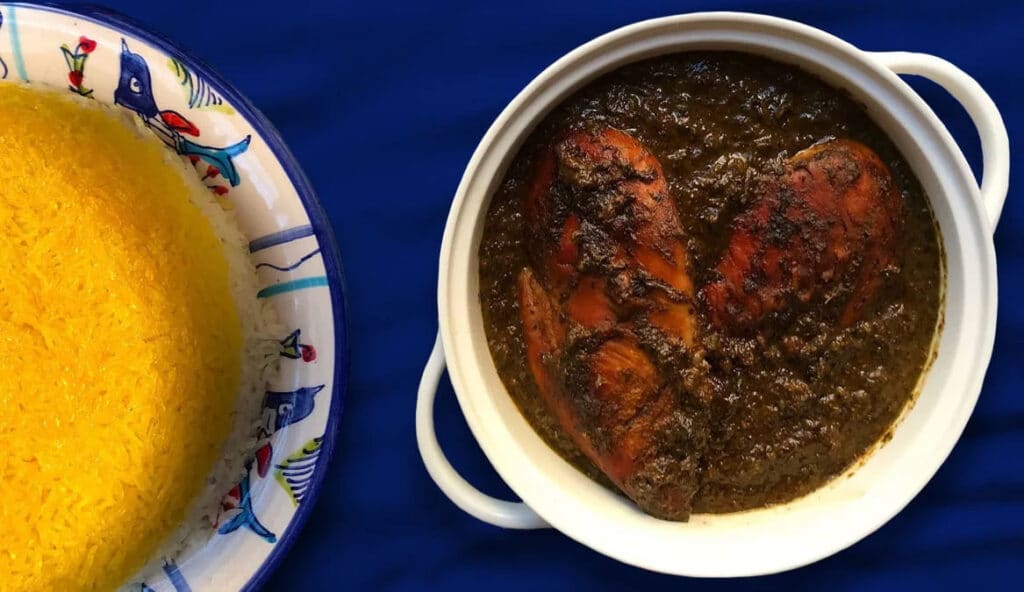
Northern Sour Chicken Stew, a ceremonial dish from Gilan and Mazandaran, uses aromatic herbs from northern Iran, though these can be substituted with available herbs. For this stew, chicken pieces are lightly sautéed and set aside.
Diced onions, optionally a few garlic cloves, and finely chopped herbs are fried, then ground walnuts are added. The chicken is layered over this mixture and cooked with sour pomegranate paste, tomato paste, and water. Some omit the walnuts, add lentils, a few sour plums, or sour orange paste to enhance the flavor, and some balance it with a bit of sugar.
13. Aash-e Choghandar (Beetroot Soup)
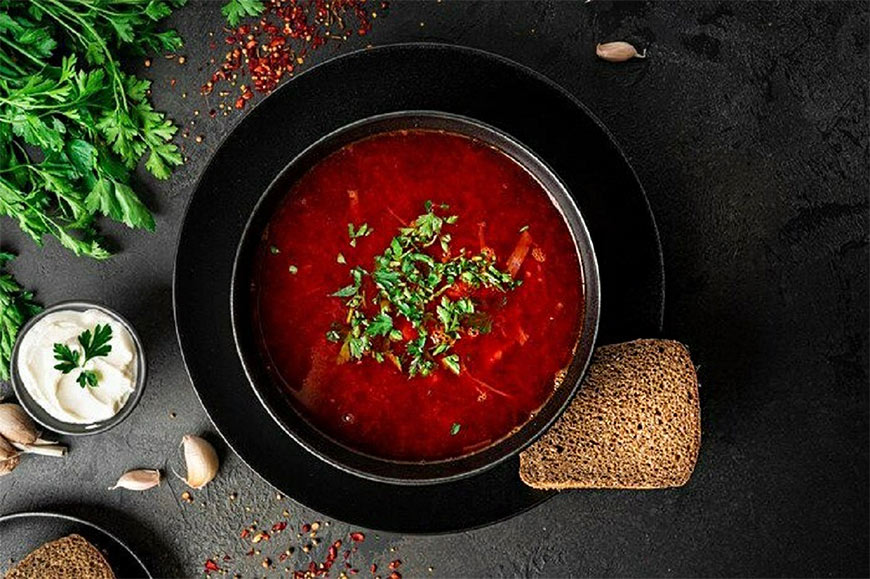
Beetroot Soup, also known as Aash-e Laboo Araki from Central Iran, is a traditional Iranian soup with a sour or semi-sweet taste, though some prefer it sweet. This soup or light meal, with its unique color and flavor, boasts amazing health benefits, especially for colds and flu. You can use white or red beets according to preference and availability.
It’s made with legumes (chickpeas, beans, lentils), beetroot, noodle-like soup pasta, chopped cilantro and parsley, kashk or whey, fried onions, and dried mint. This soup is similar to Aash-e Reshteh but includes beetroot. Some add whey at the end for a semi-sweet flavor, while others prefer it with kashk, like Aash-e Reshteh. Some recipes also include vinegar. Known by various names such as Beetroot Vinegar Soup, Gilani Beetroot Soup, Qazvin Beetroot Soup, Aashtiyan Beetroot Soup, and Isfahan Beetroot and Barley Soup, it is prepared differently in various Iranian cities.
14. Khagineh Khorma Zanjani (Zanjan Date Omelette)
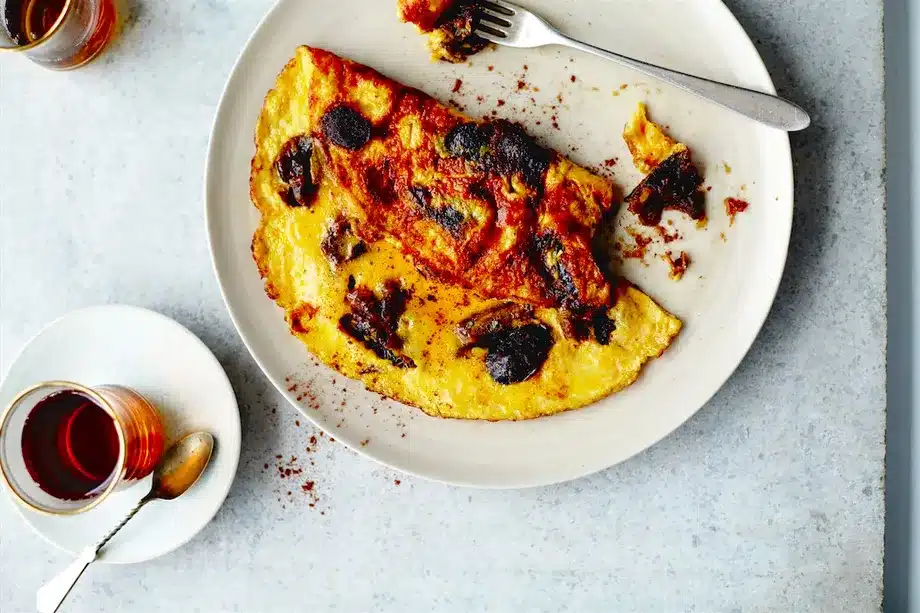
Zanjan Date Omelette is a simple yet nutritious dish prepared in Zanjan for Yalda night. It’s a warm, sweet, and energy-rich food that is also made similarly in other cities but is a traditional dish of Zanjan. Pitted dates are sautéed in butter until soft, then cinnamon, ginger, and chopped walnuts are added. Beaten eggs are poured over this mixture and cooked until set.
Finally, this nutritious omelette is served with some honey. Some add fried onions, raisins, slivered pistachios, almonds, and saffron for a more nutritious and ceremonial dish.
Another serving method is the roll-style omelette. For this, eggs are mixed with a bit of milk and flour and poured into a pan. Once it sets slightly, the date and walnut mixture with aromatic spices are spread over the egg, then rolled up and cooked thoroughly before slicing.
15. Pomegranate Tahchin (Saffron Rice with Pomegranate)
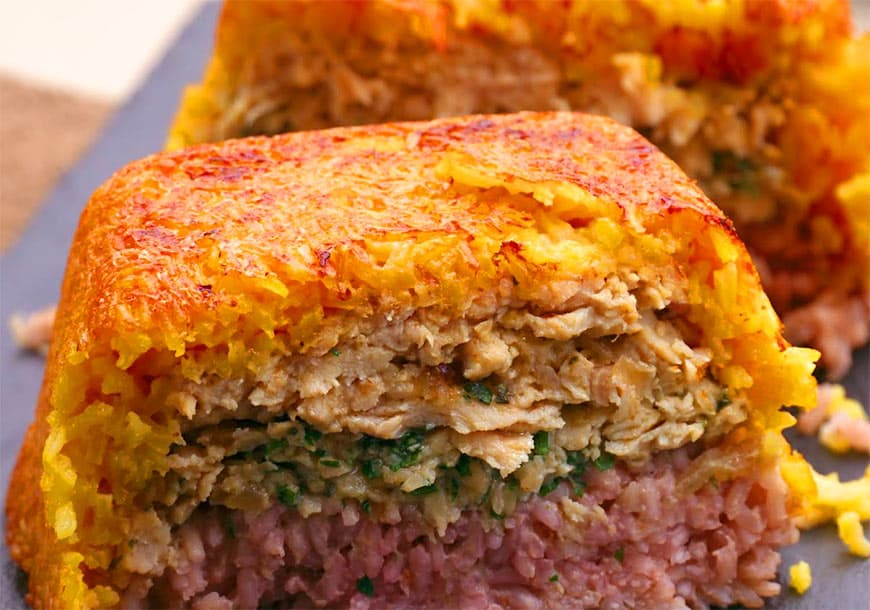
Tahchin is an authentic, ceremonial, and diverse Iranian dish prepared in various ways. Among them, Saffron Tahchin is the most well-known and popular, with many sub-varieties that can be prepared with available ingredients. When it comes to Yalda night, embellishing Saffron Tahchin with pomegranate, a beautiful and popular autumn fruit, is a natural choice. For Pomegranate Tahchin, rice is parboiled and mixed with yogurt, egg, butter, and saffron. A bit of pomegranate juice can be added to give the Tahchin a pomegranate-red hue. Chicken or meat is cooked separately, then sautéed in butter.
Diced onions are fried, and sour or sweet pomegranate seeds (depending on taste), with a little sugar if desired, are sautéed separately until some juice evaporates. Half of the saffron rice is placed in a pot or desired mold, then the mixture of ingredients (chicken or meat, fried onions, and pomegranate seeds) is added in the middle, covered with the rest of the rice. Once cooked, the Tahchin is garnished with sautéed pomegranate seeds and slivered pistachios and almonds. Some also add aromatic herbs for a better fragrance.
16. Bademjan Nardooni (Stuffed Eggplant)
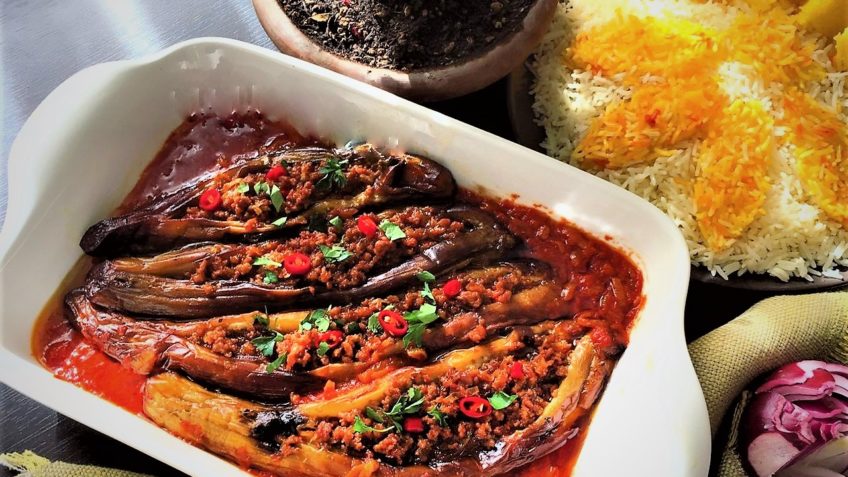
Bademjan Nardooni, as the name suggests, is an authentic northern dish now cooked in most parts of Iran, with some variations in ingredients. This semi-sweet and delicious dish gets its sourness from pomegranate seeds, pomegranate paste, and wild sour plums, and is served with northern-style steamed rice or bread. For this dish, whole eggplants are fried, then slit open.
For the filling, fried onions, walnuts, pomegranate seeds, pomegranate paste, and wild sour plums are sautéed together, optionally with some dried savory or available aromatic herbs. The mixture is stuffed into the eggplants, covered with a sauce containing pomegranate paste, and cooked until the flavors meld. Some also add ground meat and tomato paste to the filling.
17. Loboo Polo (Beetroot Rice)
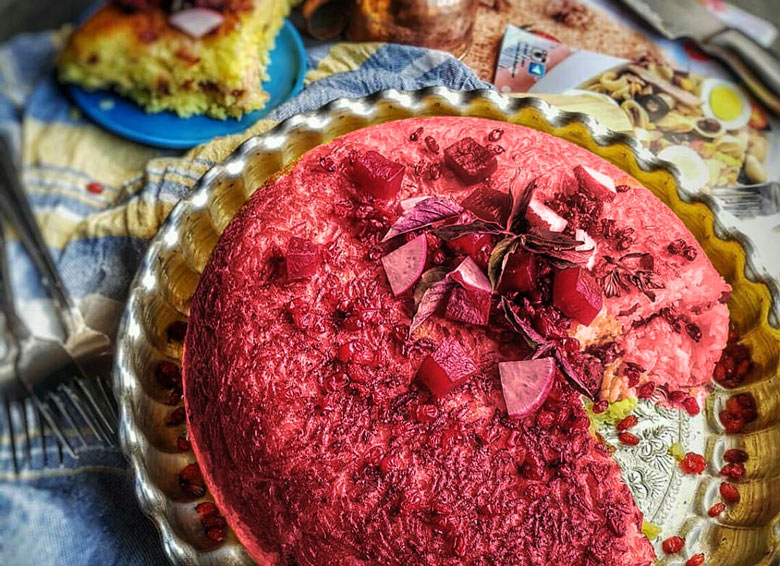
Autumn and winter, when beetroot is in season, is the perfect time for cooking various dishes and desserts with this product. Loboo Polo is one of these special seasonal dishes, a delicious mixed rice that, with its beautiful appearance, can be a suitable choice for Yalda night dinner. To prepare this colorful and delicious rice, red beets are cooked and then chopped or grated as desired.
A bit of sugar can be added to improve the flavor. Onion and chopped chicken fillet are sautéed together until the chicken is just cooked, then mixed with the chopped beetroot, saffron, and preferred spices, and set aside. The prepared ingredients are layered with parboiled rice, adding a bit more beetroot juice for color, and left to steam.
This vibrant and glossy rice is garnished with slivered pistachios and almonds and sautéed barberries when served.
Some also line the bottom of the pot with sliced beetroot to create a unique and beautiful crust. Another method involves mixing rice with egg, yogurt, and beetroot juice, layering it with the beetroot and chicken or meat mixture, and cooking it like other traditional Tahchins, either on the stove or in the oven.
Final Words
Across Iran, there are various ways to celebrate Yalda, and a wide array of foods and treats are prepared for this beautiful night. You can also share your own customs and the dishes you prepare for Yalda night with us and the users of SURFIRAN.
Read More






